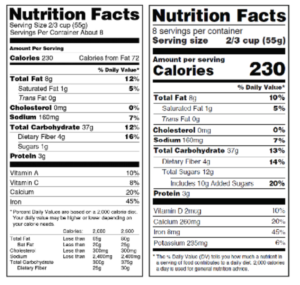
In addition to added sugars, the new label with provide information on potassium and vitamin D contents in foods while ridding of vitamins A and C. Potassium is important for fluid balance and activity in muscles and heart (hence, why you get muscle cramps if you have low potassium). The RDA for potassium is 100 mg/day.
Vitamin D is essential for strong bones and teeth as it aids calcium absorption in the body. Vitamin D is found in some foods such as fish, egg yolks, and fortified in grain and dairy products. The vitamin is also produced when skin is exposed to sunlight.
According to the FDA, vitamin D and potassium are being added to food labels because many Americans do not typically get enough of these nutrients. Vitamins A and C will be no longer be required because most Americans now get adequate amounts of the vitamins.

Other changes
The new label requires “calories” to be in larger type and bolded for easier read.
Serving sizes will also change because the law states that serving size should be based on how much consumers are eating of the product rather than how much they should be eating. For example, serving size for ice cream used to be ½ cup but will now be changed to 2/3 cup based on research indicating that is the typical serving size for consumers.
Finally, products that contain more than a single serving are required to have dual columns containing nutrition information for 1 serving as well as the entire package.
So, what does all of this mean? The intention of the FDA is to provide more information that is more applicable to consumers. Therefore, the FDA hopes that more informed decisions will be made when purchasing foods.
Source:
Labeling & Nutrition – Changes to the Nutrition Facts Label. (2018, June 28). Retrieved August 3, 2018, from https://www.fda.gov/Food/GuidanceRegulation/GuidanceDocumentsRegulatoryInformation/LabelingNutrition/ucm385663.htm



